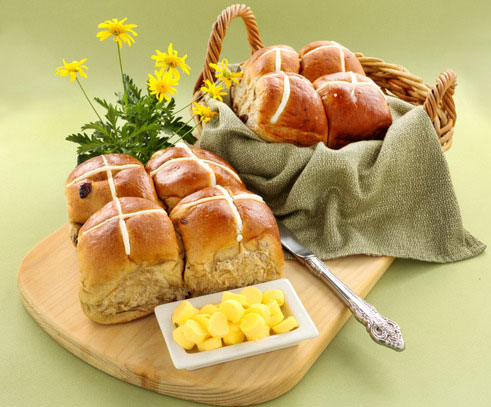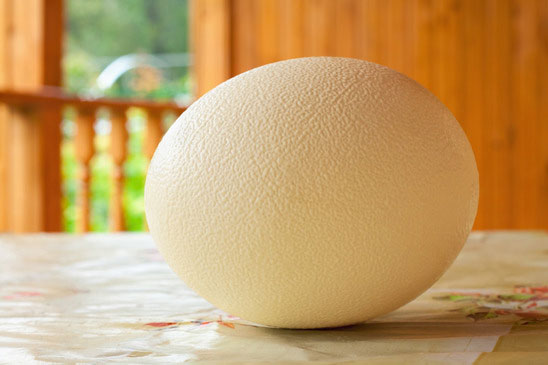Easter Treats - Baking something Special This Easter
Easter is, traditionally, a time for cooking. The historical reasons for this are obvious. By Easter, spring is already well upon us and so all of the ingredients which were lacking during winter are suddenly plentiful. Moreover, Easter is often a time in which we invite many of our friends and family over – which inevitably means providing them with food.
In this article we’ll take a look at some of the things we can cook over Easter – and focus in particular on baking. These recipes are all remarkably easy; with just a little perseverance, you can create something which your Easter guests will appreciate hugely.
Simnel CakeNo Easter baking roundup would be complete without this classic recipe, which is traditionally packed with dried fruit and religious symbolism. It consists, simply put, of two sponge cakes separated by a layer of icing and topped with eleven balls of icing – to represent every apostle bar Judas. This particular variation uses apple and cinnamon, with marzipan icing. That said, there is a huge number of different recipes and you can easily adjust the fruits and icing used in order to cater to different taste – if you’re feeling particularly creative, you can even make your own icing!
You will need:
300g marzipan
200g butter
200g caster sugar
3 Eggs
200g plain flour
1 cooking apple, cut into fine chunks
2tsp ground cinnamon
Orange and lemon zest
300g of sultanas, currants and raisins
Method
Cream butter and sugar together slowly in a bowl. You will need to ensure that the butter has had time to come down to room temperature, otherwise it will be almost impossible to break it apart. When you whisk, you introduce tiny bubbles of air into the mixture. This will lighten the mix and ensure that the sponge is appropriately spongey.
Once you have achieved a decent mixture, you can then add a couple of eggs, one at a time. This will help the mixture to adhere to itself, which will help you achieve the correct consistency. Now add some plain flour and mix further until the mixture looks good
Now you can season the mixture with a pinch of salt and begin to add the fruit. Add the currants, sultanas and raisins. If you’d prefer, you can use different concentrations of each. Add the apple and the cinnamon and you’re just about ready to go.
You should roll your marzipan so that it fits neatly inside the tray. You can do this by rolling marzipan to the desired thickness and placing the tray over the top. Reserve the remainder of the mixture for the topmost layer of the cake.
Spoon half of the cake mixture into the tray and place the first layer of marzipan on top. Then cover it with the remainder. You’re now ready to bake. A dense fruit cake of this sort needs to be cooked for a long period of time on a low temperature, so that the heat can penetrate to the core. In the case of this particular cake, we are looking at 150 degrees (gas mark 2) for around two-and-a-half hours. Patience is key; if we try to cook it any faster at a higher temperature, then the cake will not cook evenly. The outside will burn while the inside will be raw.
During cooking, you should occasionally have a look at the cake. If the top has begun to darken, then you can cover it with foil in order to keep the inside baking while ensuring that the outside is protected.
Once you’re done, leave the cake to cool for a few minutes. Spread some jam over the top, ensuring a nice even coat. This will help the topmost layer of marzipan adhere to the top of the cake. You can then add your eleven Easter eggs (or, if you’d prefer, balls of icing) in a circle, using jam to glue them to the icing. You should now be looking at an excellent simnel cake.
Hot Cross Buns
Like the simnel cake, the hot cross bun is religiously symbolic and served during Easter. Unfortunately, hot cross buns have acquired some notoriety – this is, in the main, because of the abundance of hot cross buns which have not done very well.
The quality of the ingredients will hugely influence that of the hot cross buns. Using fresh fruit will make the difference between a bland piece of sour bread and a taste explosion. Apples and pears are perfect for this. Cut them into fine chunks, no larger than half a centimetre across. You can, if you like, leave them to soak in brandy until you come to use them; you can then drink the brandy while you’re waiting for the mixture to rise, as a reward for all the hard work of kneading the dough! For this recipe, you will need:
 750g white bread flour
750g white bread flour
3 tsp salt
150g caster sugar
3 tsp dried yeast
60g butter (unsalted)
2 beaten eggs
180ml full fat milk, warm
180ml cool water
150g sultanas
Zest of 2 oranges
1 apple
1 pear
200ml brandy
3 tsp ground cinnamon
Method
To start, add salt, sugar, flour, yeast, butter and eggs to a mixing bowl. Then add the milk and a little bit of water. Use your fingers to move the mixture around in order to see how much liquid is present in the mixture and add water as appropriate.
Scatter a fine dusting of flour onto your work surface and start to work the dough into it. You should do this for a while, until the surface of the dough becomes smooth. If you can easily break the surface of the dough with your fingers, then you need to knead it a little longer in order for the gluten to properly tighten. This is the exhausting part, but it will be worth it in the end.
Once you have achieved a smooth surface, cover the bowl with a layer of Clingfilm and leave it to rest until it has doubled in size. This will take a few hours. After this is done, you can add the fruit mixture to the dough. Make sure that you thoroughly mix in the fruit. In doing this, you will also be adding a lot of moisture to the mixture. In order to counteract this effect, you can add a little bit of flour – just enough to eliminate the squelching noise as you push the dough back into shape. Now, leave the dough to rise a bit further – another hour should do the trick.
Now you are ready to divide the mixture into equal bun-sized potions. Roll them into balls and allow them to sit on the surface of a baking-paper-lined tray. If you pack them tightly, then they should adhere to one another so that they can cut neatly into single masses.
Now create your crosses. To do this, you will simply need a piping bag, some flour and some water. There is a simple method which makes this easier, particularly if you’re creating a large batch of buns. Arrange your hot cross buns into a grid and draw horizontal lines over each row. Now rotate the tray ninety degrees and repeat the process.
Unlike the simnel cake, this mixture is quite light. As such, we can blast these buns at 220 degrees (200 degrees fan, gas mark 7) for only twenty minutes. The result should be a golden brown exterior with a delightfully moist interior. As a final touch, you can glaze the buns in a jam of your choice.
Baked Ostrich Egg
Thus far we have only discussed traditional sweet options. Our final option, however, is decidedly savoury – and marries tradition with the exotic. There are few things more emblematic of Easter than an egg and there are few eggs larger than that of an ostrich.
An ostrich egg is roughly equivalent to twenty-four hen’s egg, and so requires a great deal of additional ingredients to support it. This Persian-style baked egg recipe is easy to make and will provide an eye-popping breakfast meal for all of your guests. You will need:
 4 white onions, thinly sliced.
4 white onions, thinly sliced.
6 cloves of garlic, peeled and finely chopped
4 tsp turmeric
2 tsp ground coriander
2 tsp ground cumin
1 tsp ground cinnamon
5 tbsp harissa
1 ostrich egg
500g feta cheese
Olive Oil
Salt and pepper
A loaf or two of baked ciabatta
A generous bunch of fresh coriander
Method
Oil a pan and sauté the garlic and onion until it becomes translucent. Add the spices and stir them in, so that they cling to the mixture and then add the harissa and tomatoes. Season the mixture with salt and pepper and leave it to simmer for half an hour or so, or until it has nicely reduced.
Preheat the oven to 180 degrees (160 fan, gas mark four). Finely chop half of the coriander and save the rest. Pour the source onto a sizeable baking tray and mix in the chopped coriander. Stir it in order to achieve an even mixture and crumble your feta cheese across the top.
Now for the egg. Make a nice crater in the surface of your mixture and crack the egg into it. Be careful when doing this that you do not pour it from too great a height, or the yolk will burst. Now place the mixture into the oven for fifteen or so minutes. During this time, you will need to carefully monitor the egg. The white should turn opaque, while the yolk remains nice and runny. This will allow you to dunk bread into the yolk. Or, if you’d prefer, cook the yolk through and divide the entire thing between your guests.
Once the egg is fully cooked, you can scatter it with salt, pepper and the remainder of your coriander. Congratulations; you’ve created something that your guests will not soon forget.
